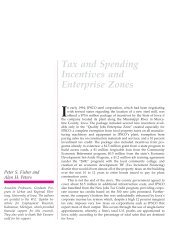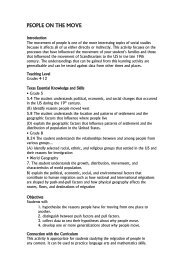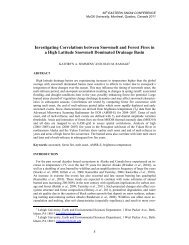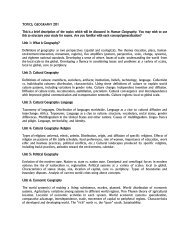This is a test of Andrew Klein's New Document Formt
This is a test of Andrew Klein's New Document Formt
This is a test of Andrew Klein's New Document Formt
You also want an ePaper? Increase the reach of your titles
YUMPU automatically turns print PDFs into web optimized ePapers that Google loves.
II. Quantitative Analys<strong>is</strong> <strong>of</strong> Landsat Thermal Imagery<br />
I. Conversion <strong>of</strong> DN values to Absolute Radiance<br />
ETM+ images are acquired in either a low or high gain state (Figure 1). The science goal in<br />
switching gain states <strong>is</strong> to maximize the instrument's 8-bit radiometric resolution without saturating<br />
the detectors. <strong>Th<strong>is</strong></strong> requires matching the gain state for a given scene to the expected brightness<br />
conditions. For all bands, the low gain dynamic range <strong>is</strong> approximately 1.5 times the high gain<br />
dynamic range. It makes sense, therefore, to image in low gain mode when surface brightness <strong>is</strong> high<br />
and in high gain mode when surface brightness <strong>is</strong> lower.<br />
Figure 1 Design ETM+ Reflective Band High and Low gain Dynamic Ranges<br />
http://landsathandbook.gsfc.nasa.gov/handbook/handbook_htmls/chapter6/chapter6.html<br />
The per-band sensitivity <strong>of</strong> the instrument <strong>is</strong> set by adjusting the gain to conditions expected for that<br />
time <strong>of</strong> year. Bands 1, 2 and 3 are set to high or low gain as a group. Gain settings for bands 5 and 7<br />
are set similarly. Band 6 acquired in both high and low gain mode, while bands 4 and 8 are set<br />
individually according to land surface brightness conditions. Band gains are set on a month by<br />
month bas<strong>is</strong>. The DN values <strong>of</strong> each Landsat image band were scaled from the absolute radiance<br />
measure to byte values prior to media output using the gain and bias (<strong>of</strong>fset) values given for each<br />
band. The DN values can be converted back to the radiance units using the following equation:<br />
Which can also be expressed as:<br />
Radiance = gain*DN + <strong>of</strong>fset (1)<br />
Radiance = ((L MAX-L MIN)/(Q CALMAX-Q CALMIN))*(Q CAL-Q CALMIN) + L MIN (2)<br />
Where: Q CALMIN=0, Q CALMAX=255 and Q CAL=Digital Number<br />
- 2 -
















